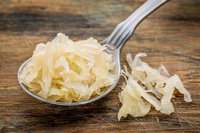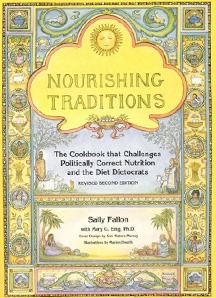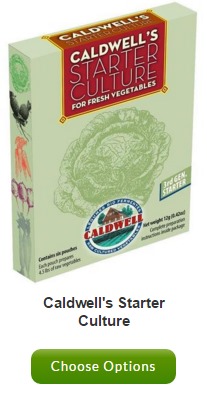- Home
- cultured vegetable starter
Blog Categories
Recent Posts
Getting Started with Fermented Foods: Lacto-Fermented Vegetables
Posted by on
Before the advent of modern day canning most of our North American foremothers understood the process of lacto-fermentation. They had crocks of real sauerkraut, lacto-fermented cucumber pickles and other treasures such as beets, onions or garlic waiting out the winter in the root cellar.

Those countries with histories deeper than our own also traditionally fermented vegetables with simply salt, water and spices – knowing that the lactic acid produced would prevent these nutritional powerhouses from putrefying, thereby keeping their family and themselves fed through winter. Kimchi from Korea and cortido from Latin America are just two of the flavorful and delicious condiments not native to our own country.
When we lost touch with this food preservation technique we also lost touch with the unparalleled health benefits that came with them. Sally Fallon, author of arguably the most well-known work on traditional Foods, Nourishing Traditions, is a huge proponent of lacto-fermentation. In her book, Fallon says the following:

“The proliferation of lactobacilli in fermented vegetables enhances their digestibility and increases vitamin levels. These beneficial organisms produce numerous helpful enzymes as well as antibiotic and anti-carcinogenic substances. Their main by-product, lactic acid, not only keeps vegetables and fruits in a state of perfect preservation but also promotes the growth of healthy flora throughout the intestine.”
After being completely overwhelmed by reading Nourishing Traditions I waited months before making sauerkraut. The concept was foreign and intimidated me. Because I have grown up in a culture that thinks you have to pasteurize everything, I wondered if I would poison my family.
If you are like I was – intimidated and a bit doubtful – then don’t be. You will know if a batch has gone bad. You will get used to, and even start to enjoy, the flavor of these healthful condiments. You will find that they are not much more difficult to assemble than a simple salad. You will actually want to keep a few jars/crocks on hand for health, flavor, and even convenience.
To be honest, I wasn’t wild about sauerkraut at first, nor the pickles that turned to mush. I found that I enjoyed bolder variations of sauerkraut such as kimchi and cortido. I also recently discovered how to make pickles keep their crunch a bit more – tannin-containing leaves such as grape, horseradish, oak, or even organic black tea. Pickles made with a small handful of these leaves are crunchy and delicious instead of mushy and off-putting like my first few batches.
So I would encourage you, if you were like me, to give lacto-fermentation a try. It is fairly simple, frugal and makes the most of your hard-earned real food. You can allow wild fermentation to take its course or you can use a starter culture to kickstart the production of lactic acid bacteria. While whey is often recommended as a starter culture, many find that it produces an unappealing flavor or texture in their vegetable ferments.
Starter cultures are specifically formulated to aid in the production of lactic acid bacteria and the acidification of the fermented vegetable. The strains of bacteria and probiotics found in an advanced starter culture, such as the Caldwell's Starter Culture for Vegetables , help to not only guarantee successful fermentation but peace of mind for those just getting started with vegetable fermentation. Established starter cultures already have great reviews and a proven track record.
I will leave you with two of my favorite flavors of lacto-fermented vegetables – cortido and dill pickles. I have come to love these little treasures so much that it makes it easy to eat them at two meals a day. Now all I need is that root cellar I dream of so that I can stock it full of giant crocks full of these tasty treasures.
Cortido
from Nourishing Traditions by Sally Fallon
- 1 large cabbage, cored and shredded
- 1 cup carrots, grated
- 2 medium onions, quartered lengthwise and very finely sliced
- 1 tablespoon dried oregano
- 1/4 – 1/2 teaspoon red pepper flakes
- 2 tablespoons sea salt
- 1 packet of Cutting Edge Starter Culture
- In a large bowl mix cabbage with carrots, onions, oregano, red chile flakes, sea salt and whey.
- Pound with a wooden pounder or a meat hammer for abou 10 minutes to release juices.
- Place in 2 quart-sized, wide mouth mason jars and press down firmly with a pounder or meat hammer until juices come to the top of the cabbage. The top of the cabbage mixture should be at least 1 inch below the top of the jars and should remain beneath the level of the brine throughout fermentation.
- Cover tightly and ferment at room temperature for at least 7-10 days, burping the quart jar daily to release naturally occurring fermentation gases. Transfer to cold storage.
Pickled Cucumbers
from Nourishing Traditions by Sally Fallon
Recipe Notes: For pickle slices simply cut cucumbers into 1/4 inch slices and cut back the room temperature fermentation time by 1-2 days.
- 4-5 pickling cucumbers or 15-20 gherkins
- 1 tablespoon mustard seeds
- 2 tablespoons fresh dill, snipped
- 2 tablespoons sea salt
- 1 packet of Cutting Edge Starter Culture
- 1 cup filtered water
- Wash cucumbers well and place in a quart-sized wide mouth jar.
- Combine remaining ingredients and pour over cucumbers, adding more water if necessary to cover the cucumbers. The top of the liquid should be at least 1 inch below the top of the jar and the vegetables should remain below the level of the brine throughout fermentation.
- Cover tightly and keep and keep at room temperature for at least 7-10 days, burping the quart jar daily to release naturally occurring fermentation gases. Transfer to cold storage.
Information provided in this communication is not designed to and does not provide medical advice, professional diagnosis, opinion, treatment or services to you or to any other individual. This is general information for educational purposes only. The information provided is not a substitute for medical or professional care, and you should not use the information in place of a visit, call consultation or the advice of your physician or other healthcare provider. Wise Choice Marketing Inc is not liable or responsible for any advice, course of treatment, diagnosis or any other information, services or product you obtain through Wise Choice Marketing Inc.



 Loading... Please wait...
Loading... Please wait...













